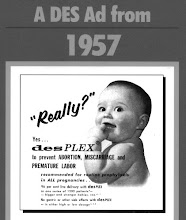
As part of routine regular checks on Australian health data, DES Action NSW has just learnt that the number of DES associated clear cell adenocarcinoma of the vagina/cervix cases held by the Adverse Drug Reactions Advisory Committee (ADRAC) has crept to 18. This means there are possibly at minimum 72,000 DES daughters, mothers and sons in Australia.
This minimum figure is unreliable for the following reasons:
- Reporting to the Adverse Drug Reactions Unit is not mandatory and failure to report is acknowledged. In spite of the reporting scheme being voluntary, it is hard for people to believe there is failure by medical professionals to report a side-effect as serious as cancer. Government minutes acquired by DES Action NSW via Freedom of Information show specific instances of the failure to report DES associated cancer cases by medical professionals. Several women have informed DES Action NSW that when recently self-reporting their DES related cancer diagnosis of years ago, they were informed by the Adverse Drug Reactions Unit that their cases had not been reported by their health care providers at time of diagnosis.
- From 1983-2001 the number of DES associated cancer case reports strangely remained static in Australia, whilst the figures elsewhere in the world were on a slow rise. The Drug Safety and Evaluation Branch’s explanation for this to DES Action NSW (letter 29/3/01) was that 1983 was “the end of the period” for identifying cases. It was explained that specialist centres within Australia were maintaining registers and that these centres chose not to report to the ADRAC. Adverse Drug Reaction Unit correspondence (31/5/01) explains the ADRAC received a phone call by an un-named doctor stating specialist clinics had been set up and that reporting to the ADRAC was not seen as necessary. In fact, there were no specialist centres within Australia maintaining registers and so the number of women diagnosed from 1983-2001 who would otherwise have been reported, remains a mystery.
On separate matter, the ADRAC was unable to afford an explanation to DES Action Australia-NSW for their 10 year delay in entering the data of a 4 year old girl diagnosed in 1972.
The maximum estimate can only be sourced from data held by the Australian Institute of Health and Welfare. The most likely appropriate data set is the women diagnosed clear cell adenocarcinoma of the vagina/cervix below age 50. (Before this cancer was linked to DES, this
cancer type was rare and typically a disease in older women.) The number currently stands at 40, which means there are possibly 160,000 DES daughters, mothers and sons. As a maximum figure this is also unreliable, since there has been no specific investigation regarding DES exposure in these women.
Having an official figure that is as accurate as possible is essential to gaining a serious approach to the DES exposure health issue in Australia. In May this year, DES Action NSW submitted a research proposal to the Cancer Council NSW that a study be undertaken to investigate available data to more accurately identify DES associated cancer cases and that this study discuss the feasibility and advantages of establishing a specific register for DES associated cancer.
THE BLUE CARD
Forms are available for self-reporting adverse drug reactions, including DES related clear cell adenocarcinoma of the vagina/cervix and other known effects of DES exposure, eg, recurrent miscarriages, T-shape uterus, undescended testes. These are available at www.tga.gov.au/adr/bluecard.htm or by phoning 1800044114 (free call)/02 62328180.
In particular, DES Action NSW encourages the reporting of DES related clear cell adenocarcinoma of the vagina/cervix, as this helps us ascertain the magnitude of the DES exposure problem in Australia. These cancer reports can be made to the TGA (online to the Adverse Event Management System (AEMS). Also report should be made to the International DES Registry which is called the Clear Cell Adenocarcinoma Registry (Chicago USA). Details are on website of DES Action USA www.desaction.org

No comments:
Post a Comment